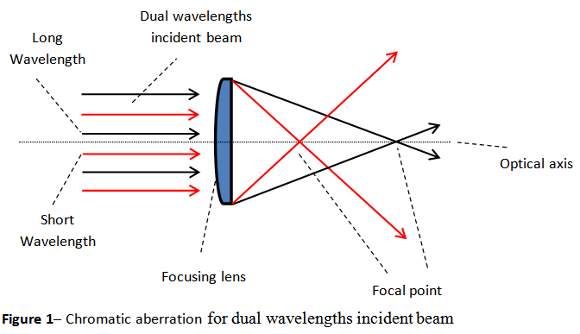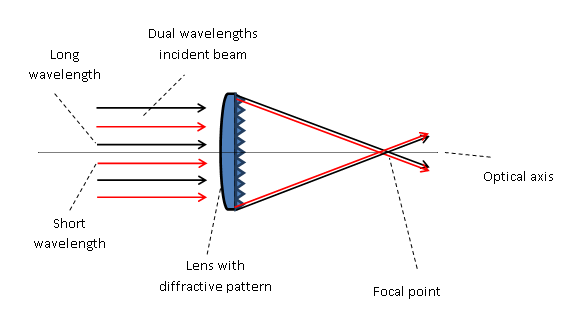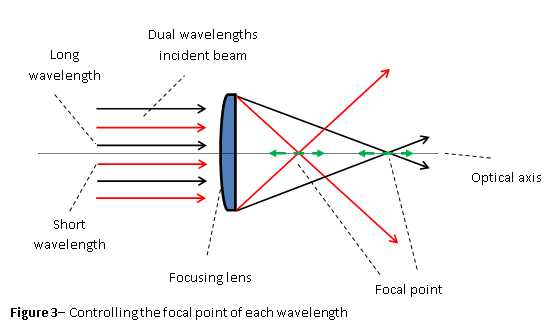
INTRODUCTION
Many laser applications as welding and surgery require the delivery of a high power infrared laser beam (usually a CO2 laser beam) and an additional visible laser whose beam is coaxially superimposed on the infrared beam, to provide a method for aiming. However, because of the frequency difference between visible and infrared light, chromatic aberration causes the lenses of the delivery system to refract visible and infrared light rays at slightly different angles. This divergence causes the two beams to be focused at different locations, resulting in imprecise aiming. A Dual wavelength focus combiner is used as a device for chromatic aberration correction . This hybrid element is based on a Plano convex lens with corresponding diffractive pattern on its Plano side.
The focal length for both wavelengths is determined during the design, according to the customer’s application.
On the other hand, some applications require the increase of chromatic aberration i.e.,to increase spatial separation of the focal points. Designing the correct DOE according to the operating wavelengths can achieve this goal as well.
Operation Principle
Laser systems that use multiple wavelengths simultaneously suffer from chromatic aberration. Shorter wavelengths will focus at a shorter distance compared with longer wavelengths. A simple case of chromatic aberration for dual wavelengths incident beams shown in Figure 1.

There are three main applications for a dual wavelengths DOE:
- The use of a DOE would correct the chromatic aberration for two wavelengths that are very far from each other, so the two operating wavelengths will have the same focal length. Usually, the diffractive pattern will influence only the shorter wavelength by extending the focal point toward the focal point of the longer wavelength (See Figure 2 below).

- The operational principle is quite straightforward. For a collimated dual wavelengths input beam (single-mode or multi-mode), the two output beams focus at a fixed and single focal length. The focal length is predetermined during the design of the DOE and is based on the longer wavelength focal length. This configuration used mostly after combination of high power infrared laser beam (usually a CO2 laser beam) and visible aiming beam for chromatic aberration correction.
- Chromatic aberration correction for two or more wavelengths that are close to each other. Here, the diffractive pattern will influence on all operating wavelengths. The specially designed diffractive pattern combines all wavelengths to the same focal point.
- Controlling chromatic aberration for two or more wavelengths that are close to each other. This application allows changing the focal length of each wavelength according to the requirements, in order to achieve fixed distance between them (See figure 3 below).

Theory
Take the common use of combining an Infrared laser beam (co2 10.6um) as an operating wavelength and a red wavelength (HeNe 633nm) as a pointer in the visible range. The Dual Wavelength focus combiner DOE has the unique possibilities to influence only on one wavelength, the shorter wavelength. A conventional plano-convex focusing lens has certain focal length for the red wavelength, fRed.
The foci spot at the “zero” order refers to the refractive FL of the lens being used.
In order to extend this Focal Length so it will be equal to the focal lens of IR wavelength, fIR , a diffractive pattern should be used. The diffractive pattern purpose is to add an “optical power” to extend/correct fRed into fIR . The correction in term of focal length, fDiffractive , is computed by the following equation:

Design considerations and limitations
The microstructure of a Dual Wavelength DOE is multilevel. Usually it is between 4 to 8 levels, although 16 level design is also possible.
For a standard Dual Wavelength element i.e., 10.6 um and 633 nm the DOE’s efficiency, at the shorter wavelength, varies from 80% to more than 90%, for 4 and 8 level, respectively. For the longer wavelength, the efficiency is closer to 100%. DW DOE can also be designed for closer wavelengths (UV-VIS, VIS-Near IR, UV-Near IR etc..).
In such cases, the considerations are slightly different because the diffractive pattern could influence both wavelengths.
Holo/Or has the capabilities and the experience to provide a professional solution according to the user’s wavelengths and specification by using in house optimization tools.
Dual Wavelength F-Theta lens
Holo/Or is offering a Diffractive F-Theta lens with Dual Wavelength lens for medical treatments and scanner systems. This option eliminates the need to place the Dual Wavelength lens inside the scanner, and provides both focal shift and field corrections. Read more about this solution .



